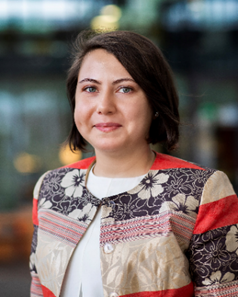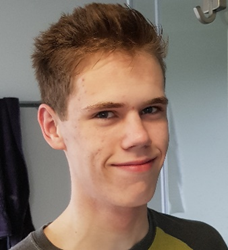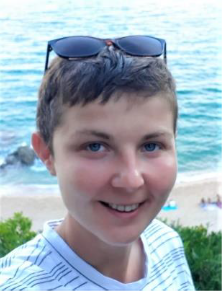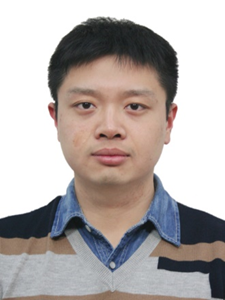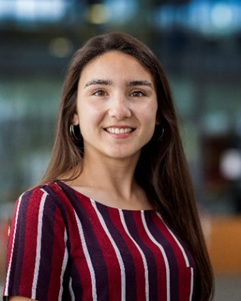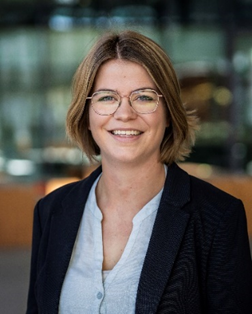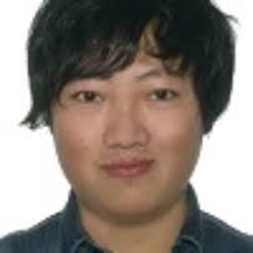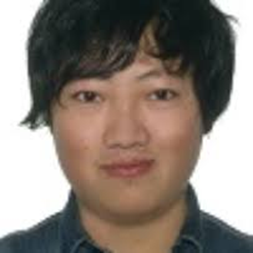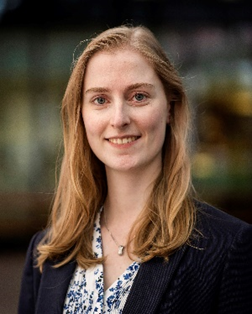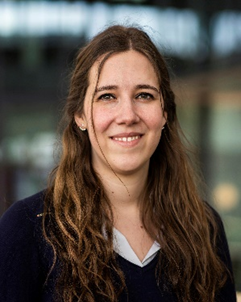Posters
|
#1 |
Gülden AkçayBio – Gülden is a PhD candidate in Mechanical Engineering within Neuro-Nanoscale Engineering group at Eindhoven University of Technology (TU/e). Her research is primarily focused on microphysiological human brain and nervous systems on chip applications testing novel technical platforms for next-generation medicines and therapies for neurological diseases and disorders.
P1.1- “Introducing Dynamic Mechano-modulation in Brain-on-Chips” Abstract: In this work, we hypothesized that a combination of a hydrogel with a relatively low Young’s modulus and a nanoscale membrane actuator forms an interface to distribute forces of a mechanical stimulus such that this mimics a neural extra-cellular matrix (ECM). We propose to use the GelMA layer as an advanced ECM mimicry in conjunction with a nanoscale membrane actuator, which is a specific BoC design previously developed in our group. When a hydrogel is placed on top of the deforming membrane, it can elicit a mechanical force field in all three of the dimensions of the hydrogel. Consequently, a biochemical signaling cascade will follow upon actuation among the cells distributed in this advanced three-dimensional (3D) material system. This way of interrogation yields eventually a distinguished 3D organization of cells upon maturation of the culture dependent on the specifics of the exerted force field vectors. In conclusion, we progressed on the design of a mechano-modulating BoC, which will allow us next to study enriched neuronal functions in vitro. |
|
#2 |
Vito FransenBio – Vito is a Mechanical Engineering student at Eindhoven University of Technology (TU/e), who is just finishing his bachelor final project under the guidance of Regina Luttge. His project attempts to further develop neurons-on-a-chip devices. He hopes to make a future in the world of MEMS and dynamic microsystems.
P1.2- “Steering axons in neurons-on-a-chip” Abstract: Studying neural signal exchange in neural networks is crucial for understanding brain diseases. To do this effectively, a consistent, reproducible control network is needed. Biopsies and well-based cell cultures are too complex and inconsistent for this purpose. This study aims to develop techniques to facilitate predetermined neural networks by steering axons with physical cues on neurons-on-a-chip devices. |
|
#3 |
Marina ShiryaevaBio – Marina is a Neurobiology student at Radboud University currently finalizing her Master studies with her final internship project at Eindhoven University of Technology (TU/e). She graduated with her BSc in Medical Sciences and Engineering from TU/e in 2020. Her Bachelor Final Project was in the field of bio-organic chemistry. Previously, she also graduated with a Technical Diploma in Civil and Environmental Engineering from the College of Building Industry and Urban Economy of Saint Petersburg in 2014 and a BSc degree in Optical Engineering from Moscow State University of Instrument Engineering and Computer Sciences in 2009.
P1.3- “Ngn2 iNeurons a a reliable workhorse for Brain-on-chip development and validation” Abstract: The Brain-on-Chip investigated here is based on microsieves. Microsieves can be fabricated by various microfabrication techniques. Such devices can support cells in culture as a scaffold alike to Extra-Cellular Matrix in vivo. The microsieve investigated in this study is made by replica molding laser ablation and contains funnel-like shapes as cell capture sites. In this work we explore Ngn2 iNeurons as a neuronal model cell system to study the working mechanism of microscale fabricated surface features inside of a 3D single cell capture site for their potentiation of mechanotransduction processes during neuronal cell differentiation. |
|
#4 |
Pan ZuoBio – Pan is a PhD candidate in the Microsystems section at Eindhoven University of Technology (TU/e) under supervision of prof. Jaap den Toonder. Pan got his master's degree of Mechanical Engineering from Eindhoven University of Technology (TU/e). In his PhD project, he performs research in the Cancer-on-a-Chip field.
P1.4- “3D-Oxygen Gradient Chip for Cancer Cell Migration Research Abstract: Metastasis, the major cause of cancer related deaths, is a multi-step procedure, influenced by many factors and cues present in the tumor microenvironment. One important but not thoroughly studied factor is hypoxia. In this study, we introduce the design, fabrication and validation of a PDMS chip to study the effect of hypoxia on the migration of cancer cells in 3D. The chip contains a cell culture chamber in which a linear and stable oxygen gradient can be established by an oxygen leaching fluid flowing through a neighboring channel, and enables to observe the migration of cancer cells in 3D. |
|
#5 |
Tanveer ul IslamBio –Tanveer is a postdoctoral researcher in the Microsystems group at Eindhoven University of Technology (TU/e). He is working on developing artificial cilia chip systems that can help understand “ciliopathies”. These are diseases caused by malfunctioning of biological cilia, microscopic hair-like protrusions are present in most organs. He obtained his M.Tech from IIT Roorkee and PhD from IIT Bombay, where he worked in the Advanced Microengineering Lab in the Department of Mechanical Engineering. During his PhD his studied how to control a fluid interface instability towards the fabrication of microfluidic devices. His work also included designing flexure mechanisms for precise control over the microfluidic processes. His current postdoctoral project is co-hosted by TU/e and EPFL in Switzerland.
P2.1- Magnetic Artificial cilia as Nano Actuators Abstract: When it comes to producing motions at nano and micro scales, nature has found an ingenious way of using a hair-like (or cantilever like) structure called “cilium“ to beat and produce motion in the surrounding fluid. Cilia are fundamental motion producing units (actuators) in cellular biology. Manipulating solid bodies like cells, particles and nutrients, present arround them, cilia are crucial for the normal functioning of various organs in our body. While more and more is being known about them, artificially mimicking them has been aimed at helping to study their functioning and developing new micro/ nanoscale engineering devices. Inspired by their multiple functioning properties, we are developing artificial ciliary systems to be employed in various applications like nano-robotics, microfluidics, drug delivery, studying ciliary systems existing in nature, etc. |
|
#6 |
Inês PereiraBio – Inês is a PhD candidate in the Microsystems section at Eindhoven University of Technology (TU/e) under supervision of prof. Jaap den Toonder. Her project is called SEAMS and aims at developing a new, magnetically actuated glaucoma implant for regulating intraocular pressure after surgery. Her research focusses on the microfluidic design and experimental testing of the new glaucoma drainage device. She graduated in 2015 from University of Beira Interior with a BSc in Biomedical Sciences, and then she obtained her MSc in Biomedical Materials and Devices from University of Aveiro in 2017.
P2.2- “Magnetically actuated glaucoma drainage device for regulating intraocular pressure after implantation” Abstract: The key risk factor for glaucoma is increased intraocular pressure (IOP). Glaucoma drainage devices that are implanted in the eye have been developed to reduce IOP and thus stop disease progression, however, the lack of proper IOP control can lead to serious postsurgical complications. To have a better control of the IOP, we are developing an innovative magnetically actuated glaucoma implant with a hydrodynamic resistance that can be adjusted following surgery.
|
|
#7 |
Emma MoonenBio – Emma is a PhD student in the microsystems group of Jaap den Toonder. She works in a multidisciplinary project called Sentinel, which aims to develop a hybrid patch for monitoring patients by measuring biomarkers in sweat. Emma received her Bsc. (2017) and Msc. (2019) in Mechanical Engineering from Eindhoven University of Technology.
P3.1- “Wearable sweat sensing device for monitoring sweat rate from single glands in sedentary state” Abstract: The current research of wearable sweat sensing is dominated by devices for monitoring of heat stressed individuals, like atheletes. Development of sweat sensing devices for individuals in sedentary state, like hospitalized patients, is hampered by the low volumes of produced sweat. While stimulation via Pilocarpine iontophoresis can increase the sweat rate temporarily, this is not desired for patients who are critically ill, and it is not a suitable solution for prolonged monitoring. When a typical micro‑fluidic channel would be placed on top of the skin, it would take hours or days to fill, eliminating the possibility to obtain any clinically relevant information in a timely manner. In this work we present an innovative solution for this problem based on sweat collection from single glands and discretized transport using electrowetting-on-dielectrics (EWOD).
|
|
#8 |
Lingju Meng, et al. (Only on display due to Covid-19 travel restrictions)P3.2- “Monolithic fabrication of microsensors based on vertically aligned carbon nanofiber by utilizing a quenching-like process” Abstract: In this work, we presented a novel fabrication process for electrochemical microsensors based on vertically aligned carbon nanofibers (VACNFs), which is accomplished by a quenching-like step. By developing this process, we successfully achieved monolithic devices, which can keep the insulation layer and VACNFs in the best forms. The microsensor is expected to possess high performance in neurotransmitter detection. |
|
#9 |
Lingju Meng et al. (Only on display due to Covid-19 travel restrictions)P3.3- “Dopamine detection by ultrasensitive microsensors based on vertically aligned carbon nanofiber” Abstract: In this work, we presented dopamine detection by our unique electrochemical microsensors based on vertically aligned carbon nanofibers (VACNFs). The sensitivity of our microsensors is beyond current state-of-the-art devices and showed rapid responses to tiny amounts of dopamine solution with concentrations as low as 100 nM. |
|
#10
|
Alissa BuskermolenP 3.4 “Real-Time Patient Biomarker Monitoring using Biosensing by Particle Mobility” Abstract: The dynamic nature of biological systems calls for technologies that can continuously monitor biomolecular concentrations. The challenges in developing such measurement technologies are sensitivity, specificity, and functionality over long timespans. Here, we present a continuous monitoring technique based on optical tracking of the Brownian motion of biofunctionalized microparticles near a biofunctionalized substrate. The use of affinity binders like oligonucleotides and antibodies allows for specific and reversible interactions of the particles with the substrate, depending on the analyte concentration. Single-molecule binding events are detected via changes in particle mobility, and parameters such as lifetimes of bound and unbound states give insight into molecular interaction kinetics and analyte concentration. Applications include inflammatory marker monitoring in critical care, product quality monitoring in industrial processes, and pollutant monitoring in environmental applications. |
|
#11 |
Maud LinssenP 3.5 “Continuous Monitoring Biosensor using Particle Mobility Tracking” Abstract: The dynamic nature of biological systems calls for technologies that can continuously monitor biomolecular concentrations. The challenges in developing such measurement technologies are sensitivity, specificity, and functionality over long timespans. Here, we present a continuous monitoring technique based on optical tracking of the Brownian motion of biofunctionalized microparticles near a biofunctionalized substrate. The use of affinity binders like oligonucleotides and antibodies allows for specific and reversible interactions of the particles with the substrate, depending on the analyte concentration. Single-molecule binding events are detected via changes in particle mobility, and parameters such as lifetimes of bound and unbound states give insight into molecular interaction kinetics and analyte concentration. Applications include inflammatory marker monitoring in critical care, product quality monitoring in industrial processes, and pollutant monitoring in environmental applications. |
|
# 12-21 |
Posters from our 1st year Challenge Based Learning (CBL) course students: 4CBL20 (2021-4) E3 Challenge 2 on Data and Health-Mobility-Energy with this year’s topic: “Brain-on-Chip” |
7th International Workshop on Healthcare, Life-Sciences, and Entrepreneurship
 Registration website for 7th International Workshop on Healthcare, Life-Sciences, and Entrepreneurship
Registration website for 7th International Workshop on Healthcare, Life-Sciences, and Entrepreneurship 7th International Workshop on Healthcare, Life-Sciences, and Entrepreneurship noreply@mailing.tue.nl
7th International Workshop on Healthcare, Life-Sciences, and Entrepreneurship noreply@mailing.tue.nlhttps://www.hlse.nl
2022-06-19
2022-06-22
OfflineEventAttendanceMode
EventScheduled
7th International Workshop on Healthcare, Life-Sciences, and Entrepreneurship 7th International Workshop on Healthcare, Life-Sciences, and Entrepreneurship 0.00EUROnlineOnly2019-01-01T00:00:00Z
To be announcedTo be announced
